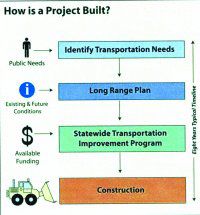The Utah Department of Transportation utilizes a number of different processes for planning the agency’s long-range goals for highways across the state. One of the most important factors influencing the transportation department’s plans is the input of citizens residing in local areas.
Unfortunately, people frequently display little interest until a bulldozer shows up in their backyards to begin work on a roadway improvement project.
To remedy the situation, UDOT is sending the department’s long range planning team to locations across the state to meet with local citizens and gather input for the state’s motorized transportation system projects, slated to take place through the year 2030.
“It takes about eight years from the time we begin working on an idea for a project to construction,” explained UDOT planner Lee Theobold at a meeting conducted in conjunction with Price city’s planning commission monthly session on Monday. “We have a 20-year guide for investments and that largely starts with these meetings.”
A small number of local citizens attended the meeting to comment on local roadway conditions, despite announcements publicized in the newspaper.
The transportation department looks at certain things in making the agency’s highway plans, pointed out Theobold at the informational gathering. First, UDOT considers the safety of roads, then looks at the bridges that may need to be built or replaced at the pavement itself and finally they look at the congestion problems certain areas may be having.
“It’s like anything else,” he told the group. “The better maintenance we do on bridges and roads now the longer they will last and the better economy they will provide. In actuality, good roads cost less over the long run.”
Carbon County residents in attendance at the meeting viewed a slide show on the development of road projects that supported what Theobold stated. Then, UDOT opened the gathering to accept public comments.
“I’m just wondering how many road projects are already scheduled for the Carbon County area already,” commented Gary Lyon, a member of the Price planning commission.
Lyon also asked whether there are anymore passing lanes being put in between Wellington and the Green River area on U.S. Highway 6.
“Right now, the division has $40 million budgeted for projects within Carbon County,” replied Theobold.
The second question asked by Lyon was answered by Kleston Laws, the Price district manager for UDOT. Laws highlighted the various roadway improvement projects that are planned.
“There are really no new passing lanes planned for that area, although there are some plans to extend a couple of the ones that are already there that ascend some of the hills on the road,” said the Price district manager.
Laws also noted some other projects that are soon to be worked on or that have funding for the next three years in the Castle Valley area.
The highway improvement projects include the following:
•Installing the bridge for the passing lane north of Sunnyside Junction.
•Completing the Helper interchange on U.S. Highway 6.
•Putting in a passing lane in Price Canyon near the old Peerless mine west of Castle Gate.
•Expanding the section of U.S. Highway 6 between Wellington and Price from two to five traffic lanes.
•Constructing passing lanes from Huntington to Poison Springs Bench in Emery County.
Residents attending the UDOT meeting brought up some other areas they thought the transportation department should consider, including Highway 10 from Price to the Four Mile Hill.
“I know that is bad,” said Laws. “It’s a very narrow corridor with a lot of houses close on both sides. We do have some money to do a study on that.”
Another concern brought up by local citizens involved the one area on the same stretch of road – the turnoff that goes to east on 1850 South.
Complaints voiced at the UDOT meeting involved the rise of the hill and the fact that cannot see very well to pull on and off the road.
Another area of concern raised at the gathering was the junction of Utah Highway 31 and U.S. 6 in Huntington. Some members of the assembled group felt that intersection needed a traffic light.
“That intersection has been studied and even though it seems it should, the study says it does not warrant a light,” said Laws.
Another area that many residents have complained about for years that was brought up in the meeting was the Peerless port of entry.
“I have never seen anything like that,” commented one member of the audience.
Laws agreed it had been a problem for years, but pointed out that there was at least one other port of entry like it, east of Monticello.
Francis Duzenack, the planning and zoning official for Price asked if a four lane road would ever be run through Price.
“When they built the by pass the part that ran through Price was taken down to two lanes, while just west of Price it is four,” he said. “Now UDOT is going to make a four lane road between Price and Wellington. When is it going to be made into four lanes through Price.”
No one had an answer for that question. It apparently has not been talked about or considered.
Another point that was brought up during the meeting was the issue of the long rumored Wellington by-pass road. Some in the room felt that if that was in the works, the new road between Price and Wellington should not be done and instead the money used for that.
“That road may come some day,” said Laws. “But I don’t think it will happen for a long time.”
Public input influences transportation department’s long-range goals

